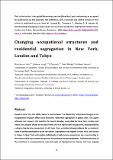Files in this item
Changing occupational structures and residential segregation in New York, London and Tokyo
Item metadata
| dc.contributor.author | van Ham, Maarten | |
| dc.contributor.author | Uesugi, Masaya | |
| dc.contributor.author | Tammaru, Tiit | |
| dc.contributor.author | Manley, David | |
| dc.contributor.author | Janssen, Heleen | |
| dc.date.accessioned | 2021-02-17T00:39:31Z | |
| dc.date.available | 2021-02-17T00:39:31Z | |
| dc.date.issued | 2020-08-17 | |
| dc.identifier | 269159436 | |
| dc.identifier | c0df948b-ab7a-4343-8403-61abcd1e9358 | |
| dc.identifier | 85089532506 | |
| dc.identifier | 000560287600002 | |
| dc.identifier.citation | van Ham , M , Uesugi , M , Tammaru , T , Manley , D & Janssen , H 2020 , ' Changing occupational structures and residential segregation in New York, London and Tokyo ' , Nature Human Behaviour . https://doi.org/10.1038/s41562-020-0927-5 | en |
| dc.identifier.issn | 2397-3374 | |
| dc.identifier.other | ORCID: /0000-0002-2106-0702/work/79226764 | |
| dc.identifier.uri | https://hdl.handle.net/10023/21440 | |
| dc.description | The research leading to these results has received funding from the European Research Council under the European Union's Seventh Framework Program (FP/2007-2013) / ERC Grant Agreement n. 615159 (ERC Consolidator Grant DEPRIVEDHOODS, Socio-spatial inequality, deprived neighbourhoods, and neighbourhood effects), from the Japan Society for the Promotion of Science KAKENHI Grant Number JP17K13584, from the Estonian Research Council (PUT PRG306, Infotechnological Mobility Laboratory, RITA-Ränne), and from TU Delft (visiting professorship of Tiit Tammaru). | en |
| dc.description.abstract | Based on data from the 1980s, Sassen’s influential book ‘The Global City’ interrogated how changes in the occupational structure affect socio-economic residential segregation in global cities. Here, using data for New York City, London and Tokyo, we reframe and answer this question for recent decades. Our analysis shows an increase in the share of high-income occupations, accompanied by a fall in low-income occupations in all three cities, providing strong evidence for a consistent trend of professionalization of the workforce. Segregation was highest in New York and lowest in Tokyo. In New York and London, individuals in high-income occupations are concentrating in the city centre, while low-income occupations are pushed to urban peripheries. Professionalization of the workforce is accompanied by reduced levels of segregation by income, and two ongoing megatrends in urban change: gentrification of inner-city neighbourhoods and suburbanization of poverty, with larger changes in the social geography than in levels of segregation. | |
| dc.format.extent | 14 | |
| dc.format.extent | 1348356 | |
| dc.language.iso | eng | |
| dc.relation.ispartof | Nature Human Behaviour | en |
| dc.subject | G Geography (General) | en |
| dc.subject | HM Sociology | en |
| dc.subject | 3rd-DAS | en |
| dc.subject | SDG 11 - Sustainable Cities and Communities | en |
| dc.subject.lcc | G1 | en |
| dc.subject.lcc | HM | en |
| dc.title | Changing occupational structures and residential segregation in New York, London and Tokyo | en |
| dc.type | Journal article | en |
| dc.contributor.sponsor | European Research Council | en |
| dc.contributor.institution | University of St Andrews. Population and Health Research | en |
| dc.contributor.institution | University of St Andrews. School of Geography & Sustainable Development | en |
| dc.identifier.doi | 10.1038/s41562-020-0927-5 | |
| dc.description.status | Peer reviewed | en |
| dc.date.embargoedUntil | 2021-02-17 | |
| dc.identifier.url | https://rdcu.be/b6jI7 | en |
| dc.identifier.grantnumber | ERC-2013-CoG | en |
This item appears in the following Collection(s)
Items in the St Andrews Research Repository are protected by copyright, with all rights reserved, unless otherwise indicated.

